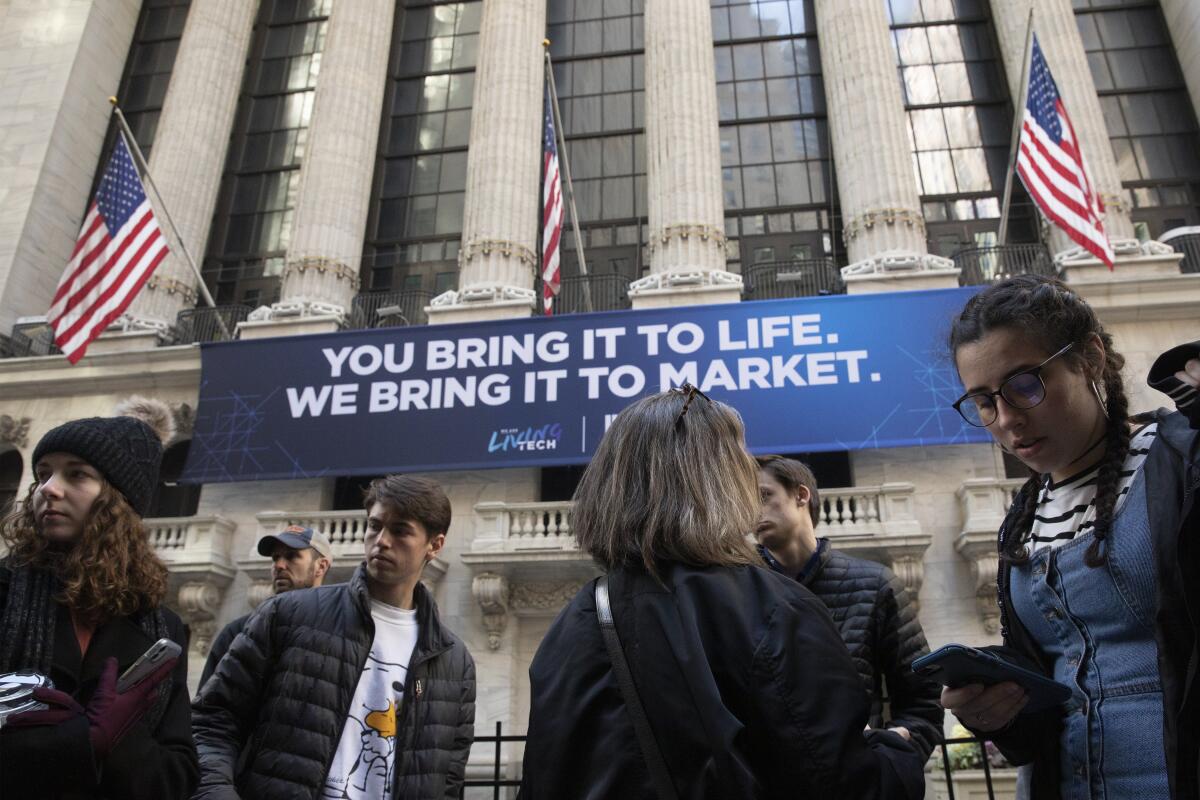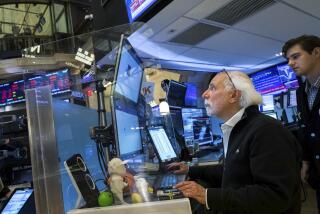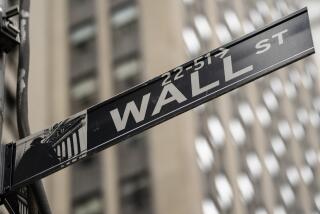Dow enters bear market as coronavirus fears push stocks down

- Share via
Stocks on Wall Street careened downward Wednesday, with the Dow Jones industrial average sinking more than 1,400 points, as investors became more fearful that the Trump administration and other global governments won’t be able to prevent the coronavirus outbreak from doing significant damage to the worldwide economy.
The Dow’s loss dragged it 20% below the record high it set last month, putting the index in a bear market. The broader Standard & Poor’s 500 index, which professional investors watch more closely, is down 19% from its peak — a single percentage point away from falling into its own bear market. If it slips that bit further, that would end one of the longest bull markets in Wall Street history.
The decline has been one of the swiftest sell-offs of this magnitude. The fastest the S&P 500 has ever fallen from a record into a bear market was over 55 days in 1987.
Vicious swings such as Wednesday’s are becoming routine as investors rush to sell amid uncertainty about how badly the virus will hit the economy. The Dow’s 5.9% drop more than erased its Tuesday leap. The 1,465-point decline stands as the index’s second-largest point drop, trailing only Monday’s 2,013-point plunge.
With Wall Street already on edge about the economic damage coming from the virus, stocks sank Wednesday after the World Health Organization called the outbreak a pandemic.
Investors are calling for coordinated action from governments and central banks around the world to stem the threat to the economy from the virus. But doubts are rising about what can come from the U.S. government, even after President Trump promised some aid.
Investors know that lower interest rates and government spending programs alone will not solve the crisis. Only the containment of the virus can do that. But such measures could help support the economy in the meantime, and investors fear that things would be much worse without them.
On Wednesday, the Bank of England became the latest big central bank to make an emergency interest rate cut in hopes of blunting the economic pain caused by the virus, which economists call the global economy’s biggest threat.
“The government probably should have been thinking about stimulus last month,” said Kristina Hooper, Invesco’s chief global market strategist. “Every day that passes makes the economic impact of coronavirus that much worse.”
Many investors are worried that a divided Congress will have trouble agreeing to any plan, she said.
The market was also weighed down Wednesday by a continued decline in oil prices, said Patrick Schaffer, global investment specialist at J.P. Morgan Private Bank.
“I want all retail investors to expect this environment will continue: sharp down days, sharp up days,” he said. “This feeling of whiplash that people feel probably continues for some period of time.”
The speed of the market’s recent declines and the degree of its swings have been breathtaking. In the last few weeks, the Dow has had seven days on which it swung by 1,000 points. A point swing that big has happened just three other times in history. That said, the percentage changes — while big — have been less dramatic when measured against historical swings. As the index has climbed, 1,000 points has made up a smaller and smaller percentage.
For most people, the new coronavirus causes only mild or moderate symptoms, such as fever and cough. For some, especially older adults and people with preexisting health problems, it can cause more severe illness, including pneumonia.
The vast majority of people recover from the new virus, but the fear is that it could drag the global economy into a recession by hitting it from both sides: supply and demand.
On the supply side, the worst-case scenario has companies with fewer things to sell as factories shut down and workplaces dim the lights because workers are out on quarantine. On the demand side, companies see fewer customers because people are huddling at home instead of taking trips or going to restaurants.
United Airlines has lost more than a third of its value since Feb. 21 because many people don’t want to risk flying. Cruise lines have also been hit hard. Even Apple, which made sharp gains in 2019, is down 6% from the beginning of the year as production of iPhones in China has been slower to grow than expected.
The coronavirus outbreak has moved so fast that its effects have not yet shown up in any nationwide economic data. Many economists still think the U.S. can avoid a recession, particularly if the virus is under control by the early summer.
But most also think the odds of recession have risen significantly in recent weeks. Measures of consumer sentiment have dropped since the beginning of the year, a sign that consumers are likely to pull back on spending in the coming weeks.
Many analysts say financial markets will continue to swing sharply until the number of new infections stops accelerating. In the United States, the number of cases has topped 1,200. Worldwide, more than 125,000 people have been infected, and more than 4,600 have died.
“There’s a real feeling that we don’t know where this ends,” said Brad McMillan, chief investment officer for Commonwealth Financial Network.
Italy’s government announced $28 billion in financial support for healthcare, the labor market and families and businesses that face a cash crunch because of the country’s nationwide lockdown on travel.
Trump was expected to announce plans for economic relief late Monday, but their viability is unclear. His proposal for a cut to payroll taxes has met resistance on Capitol Hill.
The government has to hit a narrow target to lift market optimism, all while overcoming partisan rancor to get there.
“The package must be large enough to restore confidence, but targeted enough to provide immediate relief to where it is needed most,” Mike Ryan, UBS Global Wealth Management’s Americas chief investment officer, wrote in a report.
On Wednesday, the Dow sank 1,464.94 points, or 5.9%, to 23,553.22. The S&P 500 fell 140.85 points, or 4.9%, to 2,741.38. The Nasdaq declined 392.20 points, or 4.7%, to 7,952.05.
Even a climb in Treasury yields, which has been one of the loudest warning bells on Wall Street about the economic risks of the crisis, wasn’t enough to turn stocks higher. The yield on the 10-year Treasury rose to 0.87% from 0.75%. That’s a sign of diminished demand for traditionally safe investments.
For all the fear in the market and selling by huge institutions, many regular investors have been holding relatively steady.
“People, by and large, are keeping their heads right now,” said JJ Kinahan, chief market strategist at TD Ameritrade.
Clients are mostly sticking to their long-term investment plans, he said, though some may want to adjust their portfolios if they feel uncomfortable with all the volatility. Still, the standard advice from most advisors is to focus more on long-term goals and pay less attention to short-term swings.
“We’re looking at a month of volatility as the coronavirus plays out,” Kinahan said.
Stock prices generally move on two main factors: how much profit companies are earning and how much investors are willing to pay for each $1 of them. For the first part, Wall Street is slashing its expectations, which undercuts stock prices. For the second, all the coronavirus worries make investors less willing to pay high prices. Valuations were already above historical averages before the market’s declines began.
Strategists at Goldman Sachs on Wednesday sharply cut their expectations for earnings growth this year. They said that would lead to the end of the bull market for the S&P 500, which began more than a decade ago.
A plunge in crude prices has wiped out profits for energy companies, while record-low Treasury yields are squeezing the financial sector. Strategists say S&P 500 earnings per share could fall enough to drag the index down to 2,450 points in the middle of the year. That would be a nearly 28% drop from its record.
Goldman Sachs, though, also says it expects the drawdown to be short, with earnings rebounding later in the year as the pain from the coronavirus wanes. It says the S&P 500 could climb back to 3,200 points by the end of the year.
More to Read
Inside the business of entertainment
The Wide Shot brings you news, analysis and insights on everything from streaming wars to production — and what it all means for the future.
You may occasionally receive promotional content from the Los Angeles Times.










